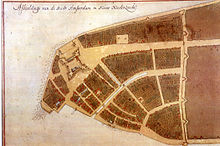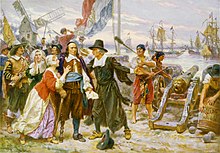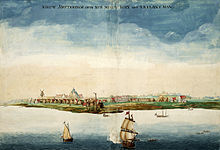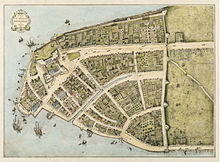New Amsterdam
From Wikipedia, the free encyclopedia
This article is about the settlement that became New York City. For other uses, see New Amsterdam (disambiguation).

The original city map of New Amsterdam called Castello Plan from 1660
(the bottom left corner is approximately south, while the top right corner is approximately north)
(the bottom left corner is approximately south, while the top right corner is approximately north)
| [show]New Netherland series |
|---|
The settlement, outside of Fort Amsterdam on Manhattan Island, in the New Netherland (1614–1664), was a provincial extension of the Dutch Republic as of 1624. Situated on the strategic, fortifiable southern tip of the island of Manhattan, the fort was meant to defend the Dutch West India Company's fur trade operations in the North River (Hudson River). Fort Amsterdam was designated the capital of the province in 1625.
The 1625 date of the founding of New Amsterdam is now commemorated in the official Seal of New York City. (Formerly, the year on the seal was 1664, the year of the provisional Articles of Transfer, assuring New Netherlanders that they "shall keep and enjoy the liberty of their consciences in religion", negotiated with the English by Pieter Stuyvesant and his council).
Long considered a dysfunctional trading post by the English who took it over, historical research has found that the city indeed left its cultural marks on later New York, and by extension the United States.[1]
| History of New York City |
|---|
| Lenape and New Netherland, to 1664 New Amsterdam British and Revolution, 1665–1783 Federal and early American, 1784–1854 Tammany and Consolidation, 1855–97 Early 20th century, 1898–1945 Post–World War II, 1946–77 Modern and post-9/11, 1978– |
| See also |
| Timelines: NYC • Brooklyn |
Contents
History
| This section needs additional citations for verification. (January 2013) |
See also: Dutch colonization of the Americas and History of New York City
Early settlement (1609–1625)
Main article: New Netherland
The first recorded exploration by the Dutch of the area around what is now called New York Bay was in 1609 with the voyage of the ship Halve Maen (English: "Half Moon"), captained by Henry Hudson[2] in the service of the Dutch Republic, as the emissary of Maurice of Nassau, Prince of Orange, Holland's stadholder. Hudson named the river the Mauritius River. He was covertly attempting to find the Northwest Passage for the Dutch East India Company. Instead, he brought back news about the possibility of exploitation of beaver pelts
in the area, leading to private commercial interest by the Dutch who
sent commercial, private missions to the area the following years.At the time, beaver pelts were highly prized in Europe, because the fur could be felted to make waterproof hats. A by-product of the trade in beaver pelts was castoreum—the secretion of the animals' anal glands—which was used for its medicinal properties and for perfumes. The expeditions by Adriaen Block and Hendrick Christiansz in 1611, 1612, 1613 and 1614 resulted in the surveying and charting of the region from the 38th parallel to the 45th parallel. On their 1614 map, which gave them a four-year trade monopoly under a patent of the States General, they named the newly discovered and mapped territory New Netherland for the first time. It also showed the first year-round trading presence in New Netherland, Fort Nassau, which would be replaced in 1624 by Fort Orange, which eventually grew into the town of Beverwyck, now Albany.
Dominican trader Juan Rodriguez (rendered in Dutch as Jan Rodrigues), born in Santo Domingo of Portuguese and African descent, arrived in Manhattan during the winter of 1613–1614, trapping for pelts and trading with the local population as a representative of the Dutch. He was the first recorded non-Native American inhabitant of what would eventually become New York City.[3][4]
The territory of New Netherland, containing the Northeast's largest rivers with access to the beaver trade, was originally a private, profit-making commercial enterprise focusing on cementing alliances and conducting trade with the diverse Indian tribes. Surveying and exploration of the region was conducted as a prelude to an anticipated official settlement by the Dutch Republic, which occurred in 1624.
Pilgrims' attempt to settle in the Hudson River area
In 1620 the Pilgrims attempted to sail to the Hudson River from England. However, the Mayflower reached Cape Cod (now part of Massachusetts) on November 9, 1620, after a voyage of 64 days.[5] For a variety of reasons, primarily a shortage of supplies, the Mayflower could not proceed to the Hudson River and the colonists decided to settle somewhere on or near Cape Cod.[5]The Dutch return
The mouth of the Hudson River was selected as the ideal place for initial settlement as it had easy access to the ocean while also securing an ice-free lifeline to the beaver trading post near present day Albany, settled in 1614, and where American Indian hunters supplied them with pelts in exchange for European-made trade goods and wampum, which was soon being made by the Dutch on Long Island. In 1621 the Dutch West India Company was founded. Between 1621 and 1623, orders were given to the private, commercial traders to vacate the territory, thus opening up the territory to Dutch settlers and company traders. It also allowed the laws and ordinances of the states of Holland to apply. Previously, during the private, commercial period, only the law of the ship had applied.In 1624 the first group of families arrived on Noten Eylant (Nut Island, now Governors Island) to take possession of the New Netherland territory and to operate various trading posts. They were spread out to Verhulsten Island (Burlington Island) in the South River (now the Delaware River), to Kievitshoek (now Old Saybrook, Connecticut) at the mouth of the Verse River (now the Connecticut River) and further north on the Mauritius or North River (now the Hudson River), near what is now Albany.
Upon first settlement on Noten Eylant in 1624, a fort and sawmill were built. The latter was constructed by Franchoys Fezard.
Fort Amsterdam (1625)
The threat of attack from other European colonial powers prompted the directors of the Dutch West India Company to formulate a plan to protect the entrance to the Hudson River. In 1625, many settlers were moved from Noten Eylant to Manhattan Island, where a citadel to contain Fort Amsterdam was being laid out by Cryn Frederickz van Lobbrecht at the direction of Willem Verhulst. By the end of 1625, the site had been staked out directly south of Bowling Green on the site of the present U.S. Custom House. The Mohawk—Mahican War in the Hudson Valley led the company to relocate even more settlers to the vicinity of the new Fort Amsterdam. In the end, colonizing was a prohibitively expensive undertaking, only partly subsidized by the fur trade. This led to a scaling back of the original plans. By 1628, a smaller fort was constructed with walls containing a mixture of clay and sand.1625–1664
Willem Verhulst, who, with his council, was responsible for the selection of Manhattan as a permanent place of settlement and for situating Fort Amsterdam, was replaced as the company director-general of New Amsterdam by Peter Minuit in 1626.To legally safeguard the settlers' investments, possessions and farms on Manhattan island, Minuit negotiated the "purchase" of Manhattan from a Manahatta band of Lenape for 60 guilders worth of trade goods. The deed itself has not survived, so the specific details are unknown. A textual reference to the deed became the foundation for the legend that Minuit had purchased Manhattan from the Native Americans for 24 dollars' worth of trinkets and beads. However, the actual price of 60 guilders in the Netherlands in 1626 amounts to around $1,100 in 2012 dollars.[6] Further complicating the calculation is that the value of goods in the area would have been different than the value of those same goods in the developed market of the Netherlands.
In 1639, Colony's Sawmill stood at the corner of East 74th Street and Second Avenue, at which African laborers cut lumber.[7][8]
The New Amsterdam settlement had a population of approximately 270 people, including infants. In 1642, the new director-general Willem Kieft decided to build a stone church within the fort. The work was carried out by recent English immigrants, the brothers John and Richard Ogden. The church was finished in 1645 and stood until destroyed in the Slave Insurrection of 1741.
A pen-and-ink view of New Amsterdam,[9][10] drawn on-the-spot and discovered in the map collection of the Austrian National Library in Vienna in 1991, provides a unique view of New Amsterdam as it appeared from Capske (small Cape) Rock in 1648. Capske Rock was situated in the water close to Manhattan between Manhattan and Noten Eylant, and signified the start of the East River roadstead.

The Fall of New Amsterdam, by Jean Leon Gerome Ferris,
showing Peter Stuyvesant (left of center, with wooden leg) standing on
shore among residents of New Amsterdam who are pleading with him not to
open fire on the English who have arrived in warships and are waiting in
the harbor to claim the territory for England.
On August 22, 1654, the first Spanish- and Portuguese-speaking Jews arrived with West India Company passports from Amsterdam to be followed in September by another sizable group of Sephardic Jews, without passports, fleeing from the Portuguese reconquest of Dutch possessions in Brazil. The legal-cultural foundation of toleration as the basis for plurality in New Amsterdam superseded matters of personal intolerance or individual bigotry. Hence, and in spite of certain private objections (including that of director-general Peter Stuyvesant), the Sephardim were granted permanent residency on the basis of "reason and equity" in 1655. Nieuw Haarlem (now known as Harlem) was formally recognized in 1658.
English capture
On August 27, 1664, while England and the Dutch Republic were at peace, four English frigates sailed into New Amsterdam's harbor and demanded New Netherland's surrender, whereupon New Netherland was provisionally ceded by director-general Peter Stuyvesant. On September 6 Stuyvesant sent lawyer Johannes De Decker and five other delegates to sign the official Articles of Capitulation. This was swiftly followed by the Second Anglo-Dutch War, between England and the Dutch Republic. In June 1665, New Amsterdam was reincorporated under English law as New York City, named after the Duke of York (later King James II). He was the brother of the English King Charles II, who had been granted the lands.[11]That same year Jan van Bonnel built a saw mill on East 74th Street and the East River, where a 13,710-meter long creek or stream that began in the north of today’s Central Park, which became known as the Saw Kill or Saw Kill Creek, emptied into the river.[12][13][14][15][16] Later owners of the property George Elphinstone and Abraham Shotwell replaced the sawmill with a leather mill in 1677.[12][17]
In 1667 the Treaty of Breda ended the conflict. The Dutch did not press their claims on New Netherland. In return, they were granted the tiny Island of Run in North Maluku, rich in nutmegs, and a guarantee for their de facto possession of Suriname, captured by them that year.
English colonial Governor Richard Nicolls made 74th Street, beginning at the East River, the southern border patent line (which was called the "Harlem Line") of the village of New Harlem (later, the village of Harlem); the British also renamed the village "Lancaster".[18][19][20][21]
In July 1673, during the Third Anglo-Dutch War, the Dutch briefly occupied New York City and renamed it New Orange. Anthony Colve was installed as the first Governor. Previously there had only been West India Company Directors. After the signing of the Treaty of Westminster in November 1674, the city was relinquished to the English and the name reverted to "New York". Suriname became an official Dutch possession in return.
Maps of New Amsterdam
New Amsterdam's beginnings, unlike most other colonies in the New World, were thoroughly documented in city maps. During the time of New Netherland's colonization, the Dutch were Europe's pre-eminent cartographers. Moreover, as the Dutch West India Company's delegated authority over New Netherland was threefold: maintaining sovereignty on behalf of the States General, generating cash flow through commercial enterprise for its shareholders and funding the province's growth; its directors regularly required that censuses be taken. These tools to measure and monitor the province's progress were accompanied by accurate maps and plans. These surveys, as well as grassroots activities to seek redress of grievances,[10] account for the existence of some of the most important of the early documents.[22]There is a particularly detailed city map called the Castello Plan. Virtually every structure in New Amsterdam at the time is believed to be represented, and by a fortunate coincidence it can be determined who resided in every house from the Nicasius de Sille List of 1660, which enumerates all the citizens of New Amsterdam and their addresses.[23]
The city map known as the Duke's Plan probably derived from the same 1660 census as the Castello Plan. The Duke's Plan includes the earliest suburban development on Manhattan (the two outlined areas along the top of the plan). The work was created for James (1633–1701), the duke of York and Albany, after whom New York City and New York State's capital Albany were named, just after the seizure of New Amsterdam by the British.[24] After that provisional relinquishment of New Netherland, Stuyvesant reported to his superiors that he "had endeavored to promote the increase of population, agriculture and commerce...the flourishing condition which might have been more flourishing if the now afflicted inhabitants had been protected by a suitable garrison...and had been helped with the long sought for settlement of the boundary, or in default thereof had they been seconded with the oft besought reinforcement of men and ships against the continual troubles, threats, encroachments and invasions of the British neighbors and government of Hartford Colony, our too powerful enemies."
The existence of these city maps has proven to be very useful in the archaeology of New York City. For instance, the excavation of the Stadthuys (City Hall) of New Amsterdam had great help in finding the exact location of the building from the Castello map.[25]
Legacy
The scholarly conclusion has largely been that the settlement of New Amsterdam is much more like current New York than previously thought. Cultural diversity and a mind-set that resembles the American Dream were already present in the first few years of this colony. Writers like Russell Shorto argue that the large influence of New Amsterdam on the American psyche has largely been overlooked in the classic telling of American beginnings, because of animosity between the English victors and the conquered Dutch.
The original 17th century architecture of New Amsterdam has completely vanished (effected by the fires of 1776 and 1835),[26][27] leaving only archaeological remnants. The original street plan of New Amsterdam has stayed largely intact, as have some houses outside of Manhattan.
The presentation of the legacy of the unique culture of 17th century New Amsterdam remains a concern of preservationists and educators. The National Park Service celebrated in 2009 the 400th anniversary of Henry Hudson's 1609 voyage on behalf of the Dutch with the New Amsterdam Trail.[28][29]
The Dutch-American historian and journalist Hendrik Willem van Loon wrote in 1933 a work of alternative history entitled "If the Dutch Had Kept Nieuw Amsterdam" (in If, Or History Rewritten, edited by J. C. Squire, 1931, Simon and Schuster).
A similar theme, at greater length, was taken up by writer Elizabeth Bear, who published the New Amsterdam Series – detective stories taking place in an alternative history where the city remained Dutch until the Napoleonic Wars and retained its name also afterwards.
Notes
- Russell Shorto (2004). The Island at the Center of the World: The Epic Story of Dutch Manhattan and the Forgotten Colony that Shaped America (First Edition ed.). New York City: Vintage Books (a Division of Random House. ISBN 1-4000-7867-9.
- Nieuwe Wereldt ofte Beschrijvinghe van West-Indien, uit veelerhande Schriften ende Aen-teekeningen van verscheyden Natien (Leiden, Bonaventure & Abraham Elseviers, 1625) p.83: "/in den jare 1609 sonden de bewindt-hebbers van de gheoctroyeerde Oost-Indischische compagnie het jacht de halve mane/ daer voor schipper ende koopman op roer Hendrick Hudson[...]"("in the year 1609 the administrators of the East Indies Company sent the half moon captained by the merchant Hudson[...]")
- Juan Rodriguez monograph. Ccny.cuny.edu. Retrieved on 2013-07-23.
- Honoring Juan Rodriguez, a Settler of New York - NYTimes.com. Cityroom.blogs.nytimes.com. Retrieved on 2013-07-23.
- Stratton, Eugene A. (1986). Plymouth Colony: Its History & People, 1620–1691. Salt Lake City: Ancestry Incorporated. ISBN 0-916489-13-2. (page 20).
- According to a calculation by the International Institute of Social History, Amsterdam at International Institute of Social History, Amsterdam, Netherlands
- Michael T. Martin, Marilyn Yaquinto (2007). Redress for Historical Injustices in the United States: On Reparations for Slavery, Jim Crow, and Their Legacies. Duke University Press. Retrieved April 14, 2013.
- Howard Dodson, Christopher Moore, Roberta Yancy, Schomburg Center for Research in Black Culture (2000). The Black New Yorkers: the Schomburg illustrated chronology. John Wiley. Retrieved April 14, 2013.
- "New York around 1650". Austrian National Library. Retrieved Jan 7, 2014.
- de Koning, Joep M.J. (July–August 2000). "From Van der Donck to Visscher". Mercator's World. Retrieved Feb 19, 2013.
- Henry L. Schoolcraft, "The Capture of New Amsterdam," English Historical Review (1907) 22#88 674–693 in JSTOR
- "The saw-kill and the making of dutch colonial Manhattan: Sawkill Lumber Co". Sawkil.com. Retrieved April 14, 2013.
- Arthur Bunyan Caldwell (1882). The History of Harlem: An Historical Narrative Delivered at Harlem Music Hall, April 24th, 1882: a Lecture. Small Talk Publishing Company. Retrieved April 14, 2013.
- Social studies. 1962. Retrieved April 14, 2013.
- Carl Horton Pierce, William Pennington Toler, Harmon De Pau Nutting (1903). New Harlem Past and Present: The Story of an Amazing Civic Wrong, Now at Last to be Righted. New Harlem Publishing Company. Retrieved April 13, 2013.
- History and commerce of New York, 1891. American Publishing and Engraving Co. 1891. Retrieved April 13, 2013.
- Anthony Lofaso (2010). Origins and History of the Village of Yorkville in the City of New York. Retrieved April 14, 2013.
- Elliot Willensky and Fran Leadon (2010). AIA Guide to New York City. Oxford University Press. Retrieved April 13, 2013.
- Eric K. Washington (2012). Manhattanville: Old Heart of West Harlem. Arcadia Publishing. Retrieved April 13, 2013.
- James Renner (2007). Washington Heights, Inwood, and Marble Hill. Arcadia Publishing. Retrieved April 10, 2013.
- "Mount Morris Bank Building". Landmarks Preservation Committee. January 5, 1993. Retrieved April 10, 2013.
- Robert Augustyn, "Maps in the making of Manhattan" Magazine Antiques, September 1995. URL accessed on December 15, 2005.
- Several reproductions of the Castello plan can be found on-line: New Netherland Project, New York Public Library, Wikimedia Commons. Colored versions from 1916 can be found here: New York University and here:New York Historical Society. A "Digital redraft of the Castello Plan of New Amsterdam in New Netherland in 1660" is an interactive map that can be found here: [1]. This map allows you to click in various places to learn more about the ownership and use of the land and buildings. All URLs accessed on February 17, 2010. A Google Earth File of the Castello Plan is posted here:[2].
- An image of the Duke's map can be found on-line at the British Library site: THE BRITISH LIBRARY URL accessed on December 15, 2005.
- A slideshow of the famous Stadt Huys dig, a landmark archaeological excavation of one of the central blocks of New Amsterdam, can be found here: [3]. A 17th-century picture of the Stadthuys can be found here: [4]. Both URLs accessed on February 2, 2011.
- NY Public Library Picture Collection. "Map of Great Fire 1776". Retrieved February 2, 2011.
- CUNY. "Map of Damages – 1835". Retrieved February 2, 2011.
- "The New Amsterdam Trail". National Park Service, New York Harbor Parks. 2009.
- "The Henry Hudson 400 Foundation".
Further reading
- Burrows, Edwin G. and Mike Wallace. Gotham: A History of New York City to 1898 (2000) excerpt and text search
- Goodfriend, Joyce D.; et al., eds. (2008). Going Dutch: The Dutch Presence in America, 1609–2009.
- Jacobs, Jaap. The Colony of New Netherland: A Dutch Settlement in Seventeenth-Century America (2009) excerpt and text search
- Kammen, Michael. Colonial New York: A History New York: Oxford University Press, 1975.
- McFarlane, Jim. Penelope: A Novel of New Amsterdam, Greer, SC: Twisted Cedar Press, 2012. 371 pages. ISBN 9780985112202
- Schmidt, Benjamin, Innocence Abroad: The Dutch Imagination and the New World, 1570–1670, Cambridge: University Press, 2001. ISBN 978-0521804080
- Scheltema, Gajus and Westerhuijs, Heleen, eds. Exploring Historic Dutch New York (Museum of the City of New York/Dover Publications, 2011). ISBN 978-0-486-48637-6
- Schoolcraft, Henry L. (1907). "The Capture of New Amsterdam". English Historical Review 22 (88): 674–693. doi:10.1093/ehr/xxii.lxxxviii.674. JSTOR 550138.
- Shorto, Russell, The Island at the Center of the World: The Epic Story of Dutch Manhattan and the Forgotten Colony that Shaped America, Doubleday, 2004. ISBN 978-0385503495
- Swerling, Beverley, City of Dreams: A Novel of Nieuw Amsterdam and Early Manhattan, Simon & Schuster, 2002. ISBN 978-0684871738
External links
| Wikimedia Commons has media related to New Amsterdam. |
- Dutch West Indies 1630–1975 on YouTube
- The New Amsterdam Trail, a downloadable audio walking tour of Lower Manhattan
- Nieuw Amsterdam to New York, an audio history from the National Parks of New York Harbor Conservancy
- New Amsterdam from the New Netherland Project
- "Conditions as Created by their Lords Burgomasters of Amsterdam" is a publication, from 1656, about goals to populate New Amsterdam
|
||





No comments:
Post a Comment
Please leave a comment-- or suggestions, particularly of topics and places you'd like to see covered